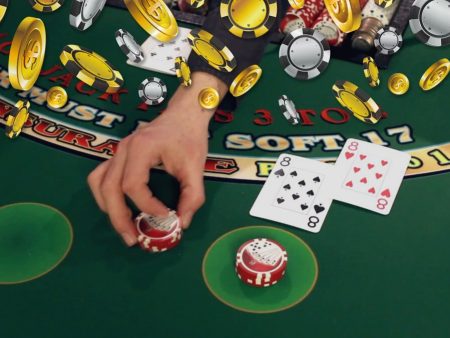The basic rule for the dealer is that she must hit until she has a total of 17 or more. Once she reaches 17 or more, she must stand. If the dealer busts, all players who are still in the game and have not busted will win.
There are a few variations to the dealer’s actions depending on the specific rules of the casino. Some casinos require the dealer to hit on a soft 17 (a hand that includes an ace that can be counted as 11). Other casinos require the dealer to stand on a soft 17. It’s important to know the specific rules of the casino you are playing at.
Once the dealer has finished playing her hand, the game is over. The dealer will collect all losing bets and pay out the winning bets. If you have a higher-scoring hand than the dealer, you will win and receive a payout. If the dealer has a higher-scoring hand or if you bust, you will lose your bet.
Conclusion
Now that you understand the basic rules of blackjack, you can confidently sit at a blackjack table and enjoy the game. Remember to make your decisions based on the cards you have and the dealer’s face-up card. Use the appropriate hand signals to communicate your decisions to the dealer. And most importantly, have fun!
to Use Basic Strategy in BlackjackUsing basic strategy in blackjack is essential for maximizing your chances of winning. Here are some tips on how to use basic strategy effectively:
1. Memorize the basic strategy chart
Before you start playing, take the time to memorize the basic strategy chart. This chart shows you the optimal move to make based on your hand and the dealer’s face-up card. You can find basic strategy charts online or purchase a laminated card from the casino gift shop.
2. Stick to the basic strategy
Once you have memorized the basic strategy, make sure to stick to it during the game. Avoid making impulsive decisions or deviating from the strategy, as this can increase the house edge and decrease your chances of winning.
3. Consider the casino’s house rules
Keep in mind that the basic strategy may vary depending on the specific rules of the casino. For example, if the dealer hits on soft 17, the strategy may be different compared to when the dealer stands on soft 17. Familiarize yourself with the house rules and adjust your strategy accordingly.
4. Don’t rely solely on basic strategy
While basic strategy is the foundation for playing blackjack, it’s important to remember that it doesn’t guarantee a win every time. Luck and other factors can still influence the outcome of the game. Use basic strategy as a guide, but also trust your instincts and make decisions based on the specific situation.
5. Practice and gain experience
The more you play blackjack and use basic strategy, the better you will become. Practice regularly and gain experience to improve your skills and decision-making abilities. Over time, you will develop a better understanding of the game and increase your chances of winning.
By following these tips and using basic strategy, you can enhance your blackjack gameplay and increase your chances of winning. Good luck!
The rules vary by casino and sometimes even by table. Blackjack games are comparable to other casino table games. Some games are better than others and some are worse. It is important to know the difference between good and bad games. Below are the most frequent variations of the rules and their effects on the player. The number of decks currently in use Blackjack’s odds of winning are influenced by the number of available decks. The casino has a greater advantage over the player if it uses more decks. You should only choose a single deck game. Common are two decks. Eight decks are the most popular game, especially in Atlantic City. Many casinos also have continuous shuffling machines. This speeds up the game and eliminates the chance of counting cards. Even if you don’t count cards, it is important to avoid games that increase the amount of bets per hour. Doubling Down Rules Variations You can double down on any 1st 2 cards. It is a good practice and something you should be looking for whenever possible. You should follow these basic strategies to determine when you can double down. This is especially important if you are counting cards. You can only double down on a total number of 9, 10 or 11. This is not terrible but it could get worse. This rule was put in place by many casinos to stop card counters. You can only double down on 10 and 11. This is the worst-case scenario for doubling down. Complain. Try other games. You can play both. It’s not permitted to double down. Refuse play in blackjack games where you are not allowed to double down. You can double down on up to 3 cards. However, many casinos limit you to only double down on your first and second 2 cards. It’s worth looking for a casino that offers this option. The rules may be too strict to allow this to be affordable. Surrendering Rules You can surrender your hand early. After looking at your 1 and 2 cards, you can give half of your bet back. Even if the dealer has an ace, you get half of your bet back. Late surrenders are allowed. The same rules apply, except that if the dealer has an automatic, you cannot surrender. Multiple Card Rules If you have 6 cards, you automatically win. It’s an uncommon rule and is hard to find right now. However, it provides a small benefit for the players. This rule isn’t often enough to increase your expectations. Get a bonus payout if you have a “5 card Charlie”, which is a hand that has 5 cards and totals 21. If the casino has this rule, it will often pay out at 2:1. It’s not as common as the automatic 6 card win and doesn’t increase your expectations. A 777 will give you a bonus payout. This option is usually limited to an 8-deck game. You may also get a bonus payout if all sevens of the same suit are present. This rule means you shouldn’t change your basic strategy. If you are required to win, don’t place side bets. This is equivalent to a straight flush in Blackjack. This rule pays at 2 to 1. If you are a 67 suited, don’t change your basic strategy. Soft 17 and the Dealer This is a huge deal, as I mentioned it briefly before. You prefer games in which the dealer must be present on any number greater than 17. Expectations will plummet if the dealer hits a soft 17. Progressive Jackpots in Blackjack Blackjack games that have progressive jackpots require you to place a side wager in order to be eligible for the jackpot. This is a problem because it is almost impossible to win. To win, you will need to have a suited hand of at least 3 cards, such as the 777 or all three diamonds. Conclusion Although your first game of Blackjack doesn’t need to be frightening, I recommend that you learn the rules for two reasons. 1. You want to be able to play without being silly or asking too many questions. 2. You should be able to pick the best blackjack games over the worst. Also, it’s worth spending the time to learn basic strategies before you start playing your first game. You can buy a basic strategy sheet if you don’t have one. It is worth the effort to play a game with a house edge less than 1%.What are the basic rules of blackjack in a casino?
If you are a novice gambler, one of the most defining moments is the first time that you sit down at a blackjack table in a casino. There is nothing quite like the experience of playing blackjack in a real casino. Players will find the sights, sounds, and the vibe of the casino to be a nerve-racking and fascinating experience.Before taking a seat, it is important to understand the basic rules of the game. Each player competes against the dealer, rather than against fellow players at the table. The aim of the game is to get as close to 21 as possible and beat the dealer. Cards 2 through 10 have their face value, face cards (Jack, Queen, and King) have a value of 10, and aces have a value of either 11 or 1. If your first two cards equal 21, you have a blackjack and will win1.5 times your bet.
Once you have understood the rules and have decided the amount of money you want to gamble with, it’s time to take a seat at the table. Now the time you put your money on the table as a bet, the dealer will give you two face-up cards and themselves two cards, only one of which will be face-up. If the dealer has a card with a value of 10, they also peek at their face-down card to check if they have blackjack.
Now, the crucial play decisions come into play. The player can hit, stand, split and double down. Hitting means to receive additional cards, standing means to stay with what you have, splitting allows you to play two hands instead of one, and double down requires the players to double their original bet and receive one additional card only. After you have either busted, lost, won, or pushed (tie) your hand, the dealer will complete their turn and a new round can be dealt.
Playing blackjack for the first time can be a daunting experience, but as long as you take your time and stick to basic strategies. With a bit of luck and strategy, you can have a great time at the blackjack tables. All the best!









